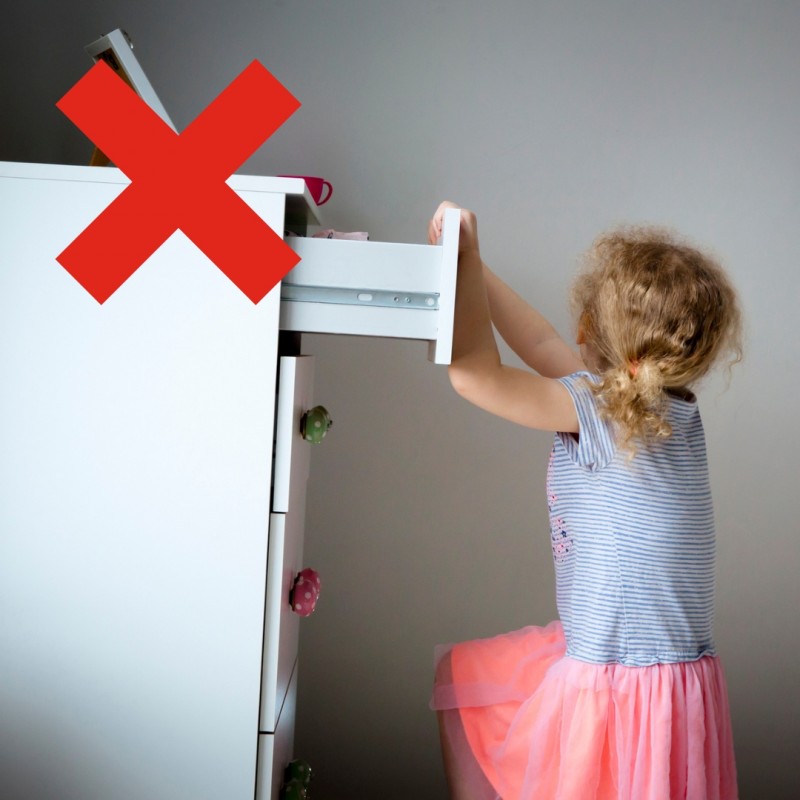A large furniture item or a television set becoming unstable and toppling over poses a potential risk of serious injury to a young child.

Red Nose, the Australian government and retailers recommend taking steps to prevent unstable furniture and TVs from toppling over and crushing a child. These include securing furniture and TVs using furniture straps, angle braces or anchors screwed into walls. Australian retailers have urged customers to read the instructions and use wall anchors / tip-over restraints supplied with large furniture items.1-3
Product Safety Australia (ACCC) warn families that furniture, such as chests of drawers, wardrobes, bookshelves, TV units or other tall items, which are not properly secured, can topple over when young children attempt to climb on, or pull themselves up on, those items of furniture.
ACCC advises: If you’re renting a home, talk to your landlord or agent to get permission to install anchor devices to the wall. Explain why you want to secure your furniture and assure them that you will repair damage caused by the installation when the tenancy ends. Make sure you get the landlord or agent’s approval in writing.4
Product Safety Australia’s safety tips include:
- Attach, mount, bolt or otherwise secure furniture and televisions to walls and floors.
- Put locking devices on all drawers to prevent children opening them and using them as steps.
- Do not put heavy items on top shelves of bookcases.
- Discourage small children from climbing on furniture.
- Do not put tempting items such as favourite toys on top of furniture that encourages children to climb up and reach.
- Do not place unstable furniture near where children play.
Red Nose is aware of a number of injuries of this nature, some being fatal, such as the death of a two-year-old girl in Western Australia who died due to an injury to her chest caused by a television set falling on her.5 Her family and the State Coroner said they hoped the inquest would stop another family being devastated by a child dying in a similar way.6
Tragically, this incident was not a one-off, the ACCC report since 2000, that 28 people, including 17 children under five, have died in Australia from toppling furniture, and each year more than 900 Australians suffer injuries requiring medical assistance from toppling furniture. Identifying that children aged up to 4 years are most at risk, with older Australians also vulnerable.
Research conducted in several countries has shown that injuries to children caused by falling televisions have become more frequent7-9 and are likely to become even more common in the future as TVs increase in size and become more affordable. Chests of drawers, dressing tables and other furniture not designed to support TVs were commonly involved in the TV-toppling incident.8,10 The most severe injuries occur in children five years or younger.11 Most often affected are the toddlers learning to walk and exploring their surrounding environments.10
Chests of drawers and dressing tables become especially unstable when the drawers are opened and can tip over.12
To prevent accidents involving furniture, ensure it is secured firmly to walls or floors, remove heavy items from the top of bookcases and cupboards and take measures to stop young children climbing on furniture.
“All freestanding household furniture can be dangerous if it falls or topples over. ACCC has a new Mandatory Standard which must include the following:
- Suppliers must warn consumers about the risk of toppling furniture by:
- attaching permanent warning labels to furniture covered by the mandatory standard
- displaying point of sale warnings, both instore and online
- including information about the risk of toppling furniture in any instruction manuals provided with storage furniture.”
By following these guidelines and being aware of the potential dangers, you can create a safer environment for your child and prevent the devastating consequences of furniture-related accidents.
Red Nose remains committed to promoting safety in the home and supports the ACCC’s efforts to protect young children through the implementation of this mandatory information standard.
To find out more access Product Safety Australia’s new Mandatory Standard here.
See the references for this article here.
Last modified: 16/7/24
